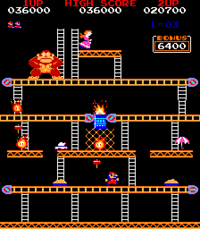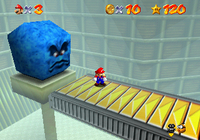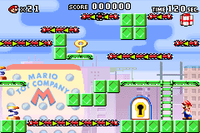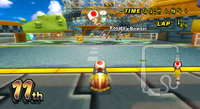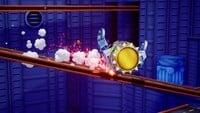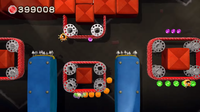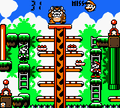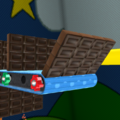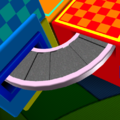Conveyor Belt
It has been requested that this article be rewritten and expanded to include more information. Reason: Donkey Kong for the Game Boy and organize and add more information on their usage in games of the Super Mario series and in Yoshi's Story
- Not to be confused with Conveyor Bolt.
- This article is about the platforms commonly found in the Super Mario franchise. For the minigame in the Nintendo DS version of Mario & Sonic at the Olympic Games, see Conveyor Belt (minigame).
| Conveyor Belt | |||
|---|---|---|---|
 A Conveyor Belt in the Super Mario 3D World style in Super Mario Maker 2 | |||
| First appearance | Donkey Kong (1981) | ||
| Latest appearance | Mario Kart World (2025) | ||
| Effect | Speeds up or slows down the player | ||
| |||
- “Avoiding the enemies as they zipped along the Conveyor Belt was intense!”
- —Nina, Super Mario Maker 2
Conveyor Belts (sometimes lowercased as conveyor belts),[1] or conveyors,[2][3][4] appear in the Super Mario franchise as platforms that can carry the player from one place to another without requiring them to move. Conveyor Belts can serve as an obstacle or a means to travel faster, depending on which direction the player is headed.
History[edit]
Donkey Kong[edit]
In Donkey Kong, Conveyor Belts appear in 50m. This level has a series of conveyor belts which run along the second, fourth and fifth floors.
Mario Bros. (Game & Watch)[edit]
In Mario Bros. for the Game & Watch, Mario and Luigi have to transport bottles through a series of conveyor belts to an awaiting truck. Conveyor belts reappear in the Modern version of Mario Bros., which appears in Game & Watch Gallery 3 and Game & Watch Gallery 4.
Mario Bros. Special[edit]
In Mario Bros. Special, every third phase has four conveyor belts that also behave like trampolines. Mario or Luigi can stun enemies by jumping on the conveyor belts when they are occupied.
Super Mario series[edit]
Super Mario Bros. 2[edit]
In Super Mario Bros. 2, conveyor belts are only found in World 7-2 and have magenta belting. Enemies are not affected by them. Unlike most other Super Mario games, they can be jumped through from beneath like a Semisolid Platform. In the original release, they have white stripes, but the conveyor belts in the Super Mario All-Stars and Super Mario Advance re-releases have yellow stripes.
Super Mario Bros. 3[edit]
Conveyor belts reappear twice in Super Mario Bros. 3, in World 6-![]() Fortress and in World 8-
Fortress and in World 8-![]() Fortress, where they appear black and white. They stop moving while a Switch Block is active.
Fortress, where they appear black and white. They stop moving while a Switch Block is active.
Super Mario World[edit]
Rope-themed conveyor belts can be found in the game files of Super Mario World, resembling the rope floors found in levels such as Gnarly, but go unused in the final game. They also have diagonal variants, which would have made them the first diagonal traditional conveyor belts in the Super Mario series before Super Mario Maker 2 formally introduced them to the series.[5] A comparable type of platform, the escalator, appears in several castles in the final game.
Super Mario Land 2: 6 Golden Coins[edit]
Conveyor belts reappear in Super Mario Land 2: 6 Golden Coins, where they have the appearance of blocks with arrows indicating the direction they are moving in. They appear in the levels Fiery Mario–Special Agent and Final Boss: One Mighty Mouse! of the Macro Zone and in Beware: Jagged Spikes of the Mario Zone.
Super Mario 64 / Super Mario 64 DS[edit]
In Super Mario 64, conveyor belts make their first 3D appearance, this time colored yellow with arrows showing the direction they are moving in. They appear only in Tick Tock Clock. Conveyor belts reappear in the remake Super Mario 64 DS, fulfilling the same purpose.
New Super Mario Bros. series[edit]
Conveyor belts are featured in many levels in New Super Mario Bros., New Super Mario Bros. Wii, New Super Mario Bros. 2, and New Super Mario Bros. U. In these games, they are commonly used to move Iron Blocks. In World Flower-Castle in New Super Mario Bros. 2, there are two Conveyor Belts that can change directions and colors (blue or red) by hitting a yellow switch, one of which appears in the battle against Lemmy.
Super Mario Galaxy[edit]
Conveyor belts reappear in Toy Time Galaxy in Super Mario Galaxy.
Super Mario 3D World[edit]
Conveyor belts also appear in Super Mario 3D World, where they only appear in the levels Bullet Bill Base and Captain Toad Gets Thwomped.
Super Mario Maker / Super Mario Maker for Nintendo 3DS / Super Mario Maker 2[edit]
Conveyor Belts return as course elements in Super Mario Maker and Super Mario Maker for Nintendo 3DS, where their speed can be adjusted by shaking them. Their direction and length can also be changed. Pressing a P Switch causes the Conveyors to stop moving. In Super Mario Maker 2, Conveyor Belts can be placed diagonally, acting as Slopes. Additionally, a new type of Conveyor Belt is introduced that is toggled by ON/OFF Switches, switching direction when one is activated.
Wario Land series[edit]
Wario Land: Super Mario Land 3[edit]
In Wario Land: Super Mario Land 3, conveyor belts appear infrequently in early levels. They first appear in Course No.12 in Mt. Teapot, then later in Courses No.15 and No.16 of Sherbet Land. They are absent until Course No.27 in the SS Tea Cup, though here, they only appear on ceilings. Bull Wario can use his horns to stick to ceiling-based ones.
Virtual Boy Wario Land[edit]
In Virtual Boy Wario Land, conveyor belts appear in Stage 6, where Honey-Bees drop bombs and watermelons over them. Others appear in the background, and Wario needs to throw a watermelon onto a Watermelon Spring to make the watermelon hit the moving object acting as a target on them.
Wario Land II[edit]
In Wario Land II, they are a little more common, appearing Escape from the factory!, Into the factory!, Move through the water!, Awaiting Syrup!, and The Final Battle!!. The direction they move can be changed with a switch.
Wario Land 4[edit]
In Wario Land 4, Conveyor Belts appear in The Curious Factory and 40 Below Fridge, working as before.
Wario Land: Shake It![edit]
Finally, in Wario Land: Shake It!, there are three types of conveyors; red, which hold their direction, blue, which can be reversed with Certainty Switches, and green, which can be turned off with their own switches. They appear in a large number of levels.
Donkey Kong Country series[edit]
Donkey Kong Country 3: Dixie Kong's Double Trouble![edit]
In Donkey Kong Country 3: Dixie Kong's Double Trouble!, a single Conveyor Belt appears in the Knautilus during the second boss battle with Baron K. Roolenstein. It switches directions during certain points in the boss fight.
Donkey Kong Country Returns / Donkey Kong Country Returns 3D[edit]
In Donkey Kong Country Returns and Donkey Kong Country Returns 3D, several Conveyor Belts appear throughout the level Slammin' Steel, where they behave as they do in other games. Notably, the boss fight with Colonel Pluck takes place on a disabled Conveyor Belt that served as an assembly line for creating Tiki Tanks.
Donkey Kong Country: Tropical Freeze[edit]
Conveyor Belts reappear in Donkey Kong Country: Tropical Freeze, where they appear in the level Fruity Factory and behave as they do in past games. They are aesthetically used for processing the fruit in the area.
Mario vs. Donkey Kong series[edit]
Conveyor belts[6][2] are frequent mechanisms used by Mario and Mini toys throughout the Mario vs. Donkey Kong series. Their design in these games generally features a row of arrows running along their body, pointing in the direction in which the conveyor belt is currently moving. With the exception of their appearance in Mario and Donkey Kong: Minis on the Move, they are always horizontally oriented and run either left or right. Conveyor Switches often accompany conveyor belts, allowing the player to change the direction of all conveyor belts in the level in order to solve puzzles. Conveyor belts can carry enemies, including fallen Thwomps, in their assigned direction.
Mario vs. Donkey Kong[edit]
In Mario vs. Donkey Kong, conveyor belts are first found in Level 1-4 of Mario Toy Company. Their color scheme depends on the world they appear in. Their main purpose is carrying Mario through tight passages while he crouches. Conveyor belts can also be used to ferry keys into more accessible areas near the exit. They also significantly impede Mario's walking speed if he runs against them, although he can still successfully walk in their opposite direction. This is the only game in the series where conveyor belts are semi-solid, meaning that they can be jumped on from underneath.
In levels with conveyor belts starting with Level 5-1, Mario often comes across Direction Switches, which he can jump on and press to reverse the direction of all conveyor belts in the level. Each Direction Switch has two red light bulbs on its sides, which alternate whenever the Direction Switch is pressed to signal a change in direction.
Mario vs. Donkey Kong 2: March of the Minis[edit]
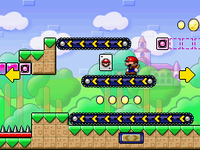
Conveyor belts appear in Mario vs. Donkey Kong 2: March of the Minis, being introduced in Room 1-7 of Mushroom Mayhem. In this game, they appear as dark blue, and their arrows resemble > and < symbols rather than triangles. If a Mini approaches a conveyor belt moving in its direction, Minis will continue to move in the conveyor belt's direction while remaining idle. However, if a Mini approaches a conveyor belt moving in the opposite direction to its own, it will simply turn around. If a Mini falls onto a conveyor belt from above, it will automatically move in the conveyor belt's direction. Minis cannot be swiped to change their direction while on a conveyor belt. Many levels with conveyor belts also feature conveyor switches, which can reverse the direction of all conveyor belts in a level when tapped with the stylus.
Mario vs. Donkey Kong: Minis March Again![edit]
Conveyor belts appear in Mario vs. Donkey Kong: Minis March Again!, functioning identically to their previous appearance. They are introduced in Room 3-2 of Magnet Mania. Magnet Mania also features a tutorial level that showcases the conveyor belt.
Mario vs. Donkey Kong: Mini-Land Mayhem![edit]
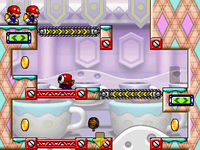
Conveyor belts also appear in Mario vs. Donkey Kong: Mini-Land Mayhem!. They are the main focus of Teatime Twirl, which also marks the debut of Purple Conveyors. Standard gray conveyor belts are called Gray Conveyors to distinguish them from Purple Conveyors. Gray Conveyors cannot be moved.[7]
Instead of being fixed in place like Gray Conveyors, Purple Conveyors can be drawn between any two purple rivets using pieces acquired in a level. Conveyor Switches affect the Purple Conveyors in the same way as Gray Conveyors. After Teatime Twirl, both Gray Conveyors and Purple Conveyors continue to appear frequently throughout the game.
Mario and Donkey Kong: Minis on the Move[edit]
Conveyor belts, known as conveyors, appear in Mario and Donkey Kong: Minis on the Move. In this game, conveyors are tiles which appear on a grid, and can carry a Mini in any of the four cardinal directions.
Mario vs. Donkey Kong: Tipping Stars[edit]
Both Gray Conveyors and Purple Conveyors reappear in Mario vs. Donkey Kong: Tipping Stars, where they are introduced in Runaway Warehouse. They function identically to their appearance in Mario vs. Donkey Kong: Mini-Land Mayhem!.
Donkey Kong Jungle Beat[edit]
In Donkey Kong Jungle Beat, vertical conveyors appear in the Clock Tower, moving up to assist Donkey Kong with Wall Jumps.
Super Smash Bros. Brawl[edit]
- SmashWiki article: Conveyor belt
Conveyor Belts also appear in Super Smash Bros. Brawl, as a Custom Stage Builder part. They are unlocked by creating at least five custom stages.
Mario Kart series[edit]
This section is a stub. Please consider expanding it to include any missing information. Specifics: Mario Kart World
Mario Kart Wii[edit]
Conveyor Belts make their debut in the Toad's Factory course from Mario Kart Wii. The arrows and colors on the conveyor belts reveal which direction they are going in. Thus, the player will become faster while driving on green conveyor belts going forward. However, driving on backward yellow conveyor belts will slow down the player. Item Boxes and crates can be found on these conveyor belts.
Mario Kart 8 / Mario Kart 8 Deluxe[edit]
In Mario Kart 8, conveyor belts appear as trickable objects in Sunshine Airport. They are colored black here. They also appear in Rainbow Road, where they have the same purpose as in Mario Kart Wii, though the color of the backward conveyor belts are red instead of yellow.
In Mario Kart 8 Deluxe, conveyor belts later replace the escalators of Wii Coconut Mall, and also appear on 3DS Rainbow Road and Tour Singapore Speedway, with the arrows on the former now being bigger.
Mario Kart Tour[edit]
In Mario Kart Tour, Conveyor Belts appear on DS Peach Gardens T, Wii Coconut Mall, Singapore Speedway 2, RMX Bowser's Castle 1 and Piranha Plant Cove 3R/T, where they serve the same function as before. In Singapore Speedway 2, ramps can be found on the conveyor belts, similar to Mario Kart 8's Rainbow Road.
Mario & Luigi series[edit]
Mario & Luigi: Bowser's Inside Story / Mario & Luigi: Bowser's Inside Story + Bowser Jr.'s Journey[edit]
Conveyor Belts appear again in Mario & Luigi: Bowser's Inside Story and its remake, where they are composed of black cylinders. They are found in Bowser Path, Bowser's Castle, and Peach's Castle, where the latter two locations also feature Fawful-like generators that indefinitely spawn pairs of Bob-ombs moving in lockstep across Conveyor Belts; the Bob-ombs can be avoided by jumping or using a Body Slam. Bowser can also be seen going against a conveyor belt for part of his conversation to the Shy Guys he released from the cage.
Mario & Luigi: Dream Team[edit]
Conveyor Belts also appear in Mario & Luigi: Dream Team, where they are exclusively found in certain areas of the Dreampoint in Dreamy Wakeport. If the "fast" setting of Luiginary Speedometer is activated, Mario will be able to effortlessly run against the direction of Conveyor Belts.
Mario & Luigi: Brothership[edit]
Conveyor belts in Mario & Luigi: Brothership mainly appear in Great Lighthouse Islands and a few other places such as Wayaway Island. Rooms where they are featured often require the Bros. to traverse them using conveyors, which may also host obstacles on their path. These include wooden and metal crates Mario and Luigi must use as platforms, and yellow barriers only Bros. Ball can go through. The boss Sharpcask, a monster that resembles a Barrel and uses barrels to attack and is fought in the Color-Full Sea, Great Lighthouse Island, sits on a conveyor belt. When it retracts into its shell, Luigi must use his Luigi Logic to manipulate the conveyor belt. This leads to a minigame where he can move Sharpcask under some crates. Stacking enough metal boxes onto it will send it down a flight of conveyor belts and stun the creature for several turns, breaking its shield.
Yoshi series[edit]
Yoshi's New Island[edit]
Conveyor Belts are present in Yoshi's New Island in the level Hotfoot Hurdle. They are rather short and float above lava, being usually placed in rows or above each other. They run left (as signified by the three green arrows displayed on them) to make it more difficult for Yoshi to advance to the right.
Yoshi's Woolly World / Poochy & Yoshi's Woolly World[edit]
In Yoshi's Woolly World and Poochy & Yoshi's Woolly World, Conveyor Belts appear only in Feel Fuzzy, Get Clingy, where they are made of the hooks from a hook-and-loop fastener (colloquially known as Velcro). As Yoshi is constructed from yarn in this game, touching a conveyor belt makes him cling to the surface, such that Yoshi can hang off the side of a vertical conveyor belt or on the underside of a horizontal conveyor belt. The conveyor belt can then carry Yoshi along its path which is necessary to proceed through the course and reach some hidden areas.
Clinging to a conveyor belt is a unique state loosely similar to the crouching state, as it uses the same pose and has the same restrictions of preventing Yoshi from creating yarn balls and throwing yarn balls. Unlike crouching, Yoshi can move left and right while stuck to a horizontal conveyor belt, or up and down while stuck to a vertical conveyor belt. On a vertical conveyor belt, moving in this way does not allow Yoshi to change direction. If Yoshi jumps while on a vertical conveyor belt , he performs a special low quick jump where he flips. If Yoshi is facing upward on a vertical conveyor belt, this jump's default trajectory is aimed at a point on the conveyor belt a short distance away from Yoshi, so the jumps can be used to advance faster. If Yoshi is facing downward, then to perform the special jump the player has to jump away from the conveyor belt, and the result is that the special jump is aimed left or right to match the player's directional input. If Yoshi is pushed into a solid platform by a conveyor belt he is clinging to, he quickly falls off the conveyor belt. Similarly, taking damage forces Yoshi off of a conveyor belt.
If a yarn ball that is not in Yoshi's possession touches a conveyor belt, then it sticks to it until one of two things happen. If Yoshi touches the yarn ball, he collects it. If the yarn ball is pushed into a solid platform, the yarn ball falls off the conveyor belt. If Poochy touches a conveyor belt, he gets completely stuck, but as he is still moving he is still able to defeat enemies on contact. While stuck, Poochy does not respond to any of the player's actions, though the player can still stand on Poochy. The only ways for Poochy to escape a conveyor belt are if he is pushed into a solid platform, which knocks him out of the course, or if the player scrolls Poochy off the screen far enough. The only way for Poochy to appear in Feel Fuzzy, Get Clingy is through the Play alongside Poochy! Power Badge, meaning Poochy will respawn immediately after these methods apply. if the Power Badge is removed, Poochy will leave the course regardless of if he is or is not stuck to a conveyor belt
Burrberts are almost always attached to a Conveyor Belt, and they get carried along in much the same way Yoshi is. Some Burrberts roll while attached to a conveyor belt, which can either allow them to advance in the direction opposite the movement of the conveyor belt or to roll in place on a conveyor belt. Some conveyor belts run beneath or above purple pipes so that Burrberts can be carried out of and back into the pipes.
Poochy & Yoshi's Woolly World adds the Poochy Pups. They do not stick to conveyor belts. If Yoshi throws the red yarn balls he gains access to when he attempts to throw a Poochy Pup but none of them are available, the red yarn balls despawn on contact with conveyor belts instead of sticking to them.
Paper Mario: Color Splash[edit]
Conveyor Belts in Paper Mario: Color Splash, take the form of green flooring attached to paper rolls. They appear in the Crimson Tower, where enemies such as Goombas and Shy Guys walk on them. Mario can hit one of the Conveyor Belts from below to knock off the Shy Guys running on top of it. Unlike in other games, these Conveyor Belts are not reversible and have a set speed. In Black Bowser's Castle, three large conveyor belts lead into a large mixer of black paint. Paint Guys stand on these, dump their paint in, and then stick to the backside of the conveyor belt. Mario holds Huey above his head and boards the conveyor belt, causing a Snifit to let him pass.
Gallery[edit]
Sprites and models[edit]
Screenshots[edit]
Mario vs. Donkey Kong: Tipping Stars (Nintendo 3DS)
Paper Mario: Color Splash (Black Bowser's Castle)
Super Mario Maker 2 (Super Mario World style)
Super Mario Maker 2 (New Super Mario Bros. U style)
Names in other languages[edit]
Conveyor Belt[edit]
| Language | Name | Meaning | Notes |
|---|---|---|---|
| Japanese | ベルトコンベア[8]:70,119,151,201,217 Beruto Konbea |
Belt Conveyor | |
| 動く床[8]:41 Ugoku Yuka |
Moving Floor | Super Mario Bros. 3 | |
| 矢印ブロック[9] Yajirushi Burokku |
Arrow Block; shared with an object in Wario World | Super Mario Land 2, block version | |
| Chinese (simplified) | 传送带[?] Chuánsòngdài |
Conveyor Belt | |
| Chinese (traditional) | 傳送帶[?] Chuánsòngdài |
Conveyor Belt | |
| Dutch | Lopende band[10] | Conveyor belt | |
| French | Tapis roulant[?] | Conveyor belt | |
| German | Förderband[11] | Conveyor belt | |
| Italian | Nastro trasportatore[?] | Conveyor Belt | |
| Korean | 벨트컨베이어[12] Belteu Keonbeieo |
Belt Conveyor | |
| Portuguese (NOE) | Tapete rolante[13] | Conveyor belt | |
| Russian | Конвейер[14] Konveyer |
Conveyor | |
| Spanish | Cinta transportadora[?] | Conveyor belt |
Fast Conveyor Belt[edit]
| Language | Name | Meaning | Notes |
|---|---|---|---|
| Japanese | こうそくベルトコンベア[?] Kōsoku Beruto Konbea |
High-Speed Belt Conveyor | |
| Chinese (simplified) | 高速传送带[?] Gāosù Chuánsòngdài |
High-Speed Conveyor Belt | |
| Chinese (traditional) | 高速傳送帶[?] Gāosù Chuánsòngdài |
High-Speed Conveyor Belt | |
| French | Tapis roulant rapide[?] | Fast conveyor belt | |
| Spanish | Cinta transportadora rápida[?] | Fast conveyor belt |
References[edit]
- ^ Pelland, Scott, and Dan Owsen (1996). Super Mario 64 Player's Guide. Redmond, WA: Nintendo of America (English). Page 113.
- ^ a b 2010. Mario vs. Donkey Kong: Mini Land Mayhem! North American instruction booklet (PDF). Nintendo of America (English). Page 17.
- ^ Mario and Donkey Kong: Minis on the Move How to Play no. 21 (Conveyor)
- ^ Mario vs. Donkey Kong: Tipping Stars Workshop object name
- ^ Super Mario World (SNES)/Unused Graphics & Objects. The Cutting Room Floor. Retrieved March 25, 2025.
- ^ 2004. Mario vs. Donkey Kong instruction booklet (PDF). Nintendo of America (English). Page 24.
- ^ 2010. Mario vs. Donkey Kong: Mini-Land Mayhem! instruction booklet (PDF). Nintendo of America (English). Page 16. Archived November 22, 2010, 21:38:48 UTC from the original via Wayback Machine. Retrieved March 13, 2018.
- ^ a b Sakai, Kazuya (Ambit) et al. (October 19, 2015). Super Mario Bros. 3 section. Shogakukan (Japanese). ISBN 978-4-09-106569-8.
- ^ 2015. Super Mario Bros. Hyakka: Nintendo Kōshiki Guidebook, Super Mario Land 2: 6 Golden Coins section. Shogakukan (Japanese). Page 78.
- ^ „Wissel van spoor of verander de richting van lopende banden.” ("Switch track or change the direction of conveyor belts.") – Nintendo Nederland (May 15, 2019). Super Mario Maker 2 Direct - 16 mei 2019 (3:18). YouTube. Retrieved May 16, 2019.
- ^ 2004. Mario vs. Donkey Kong European instruction booklet (PDF). Nintendo of Europe (German). Page 37. Retrieved March 3, 2025.
- ^ "레일을 바꾸거나 벨트컨베이어를 반전시키는 등" – 한국닌텐도 공식 채널 (May 16, 2019). 슈퍼 마리오 메이커 2 Direct 2019.5.16 (3:14). YouTube (Korean). Retrieved November 11, 2022.
- ^ «Podem alterar as faixas ou a direção dos tapetes rolantes.» – Nintendo Portugal (May 15, 2019). Super Mario Maker 2 Direct - 15/05/2019 (3:18). YouTube (Portuguese). Retrieved January 10, 2021.
- ^ NintendoRU (May 15, 2019). Super Mario Maker 2 Direct - 16/05/2019. YouTube (Russian). Retrieved May 17, 2019.[dead link]
- Platforms
- Donkey Kong (game) objects
- Donkey Kong Country 3: Dixie Kong's Double Trouble! objects
- Donkey Kong Country Returns objects
- Donkey Kong Country: Tropical Freeze objects
- Donkey Kong Jungle Beat objects
- Mario Bros. (Game & Watch)
- Mario Kart 8 objects
- Mario Kart Wii objects
- Mario Kart World objects
- Mario vs. Donkey Kong objects
- Mario vs. Donkey Kong 2: March of the Minis
- Mario vs. Donkey Kong: Mini-Land Mayhem!
- Mario vs. Donkey Kong: Minis March Again!
- Mario vs. Donkey Kong: Tipping Stars
- New Super Mario Bros. objects
- New Super Mario Bros. 2 objects
- New Super Mario Bros. U objects
- New Super Mario Bros. Wii objects
- Nintendo Land objects
- Super Mario 3D World objects
- Super Mario 64 objects
- Super Mario Bros. 2 objects
- Super Mario Bros. 3 objects
- Super Mario Bros. Wonder objects
- Super Mario Galaxy objects
- Super Mario Maker objects
- Super Mario Maker 2 objects
- Super Smash Bros. series objects
- Paper Mario: Color Splash objects
- Yoshi's New Island objects
- Yoshi's Story objects
- Yoshi's Woolly World objects
